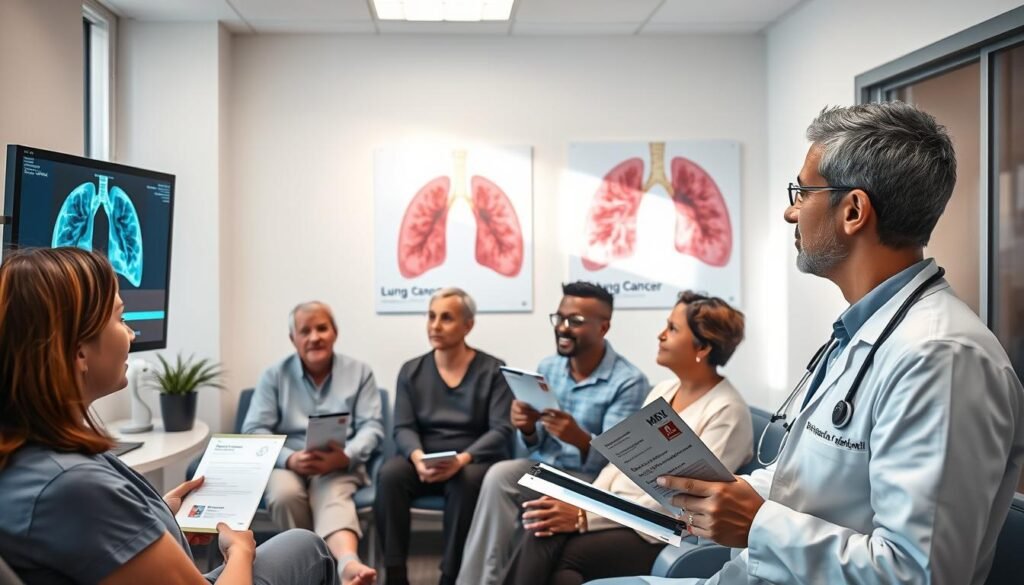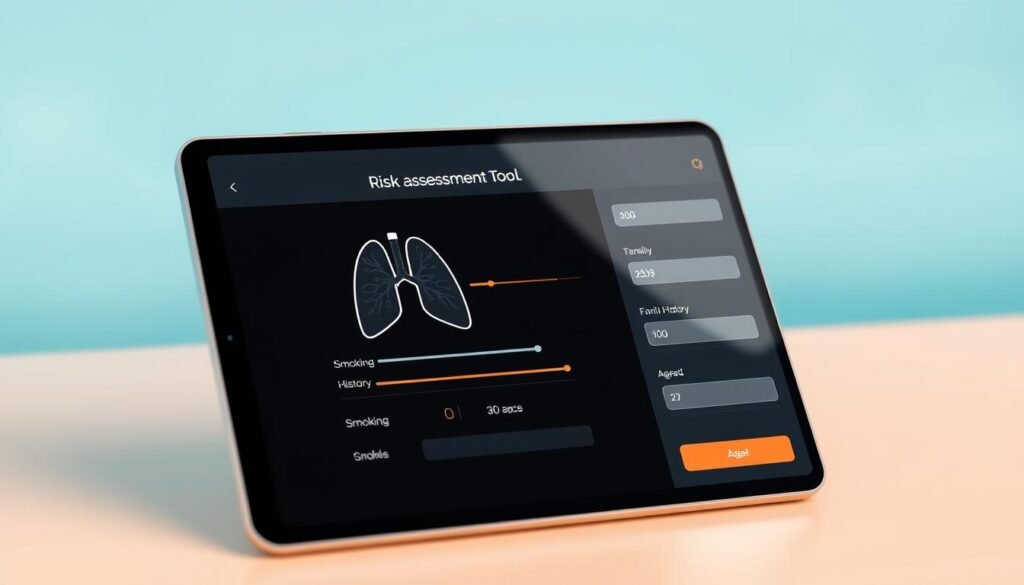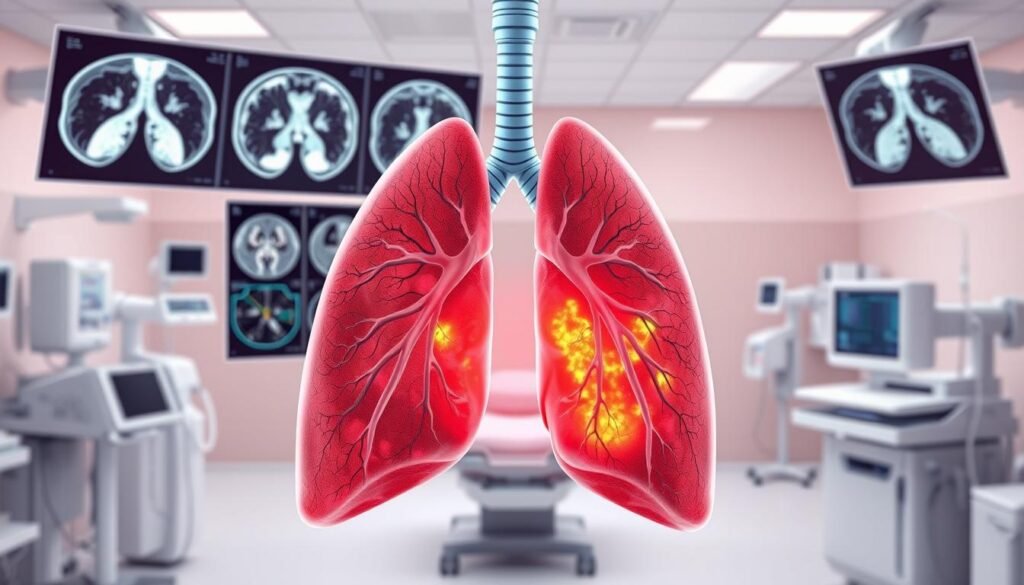Did you know that about 54% of patients with nodules from 7 to 30 mm have cancer? The VA Cooperative Study shared this scary fact. It shows why using tools like the Mayo Lung Cancer Risk Calculator is vital. This tool looks at smoking history, age, and if cancer runs in your family to figure out your risk.
Using the Mayo Lung Cancer Risk Calculator helps catch lung cancer early. Knowing your risk lets you make smart health choices. This can lead to better treatment success and health.
Key Takeaways
- The Mayo Lung Cancer Risk Calculator provides personalized risk assessments.
- It takes into account factors like smoking history and age for accurate scoring.
- Early detection through lung cancer screening can significantly improve treatment outcomes.
- 54% of lung nodules between 7 to 30 mm are malignant, underscoring screening importance.
- Proactive health decisions are essential for effective lung cancer prevention.
Introduction to Lung Cancer Risk Assessment
Lung cancer risk assessment is key in finding who needs early screening and care. It looks at risk factors like smoking, harmful environmental exposure, and genes. Knowing these risks helps focus on those most in need.
Correct risk evaluation is vital to raise lung cancer awareness. Tools like the Mayo Lung Cancer Risk Calculator offer deep insights. They help health pros and people decide wisely about lung cancer checks and care.
Lung cancer caused 1.8 million deaths worldwide in 2020, stats show. Early spotting through the right checks can greatly improve survival chances. This shows how vital good risk assessment methods are.
What is the Mayo Lung Cancer Risk Calculator?
The Mayo Lung Cancer Risk Calculator is a key tool for assessing lung cancer risk. It uses personal and family health histories to predict lung cancer risks accurately. This makes understanding one’s own risk clearer.
It allows for personalized screening plans based on each person’s unique situation. This highlights how important lifestyle choices, like smoking, impact cancer risk. Smokers over 50 find this tool especially useful.
Lung cancer is rated in stages from 1 to 4, with higher numbers showing more advanced cancer. Knowing this is vital for deciding on screening tests. This tool helps people make informed decisions about their health. It stresses the importance of catching cancer early.
Overview of the Mayo Lung Cancer Risk Calculator
The Mayo Lung Cancer Risk Calculator is a big step forward in personalized medicine. It lets doctors figure out how likely someone is to get lung cancer. This considers their health history and lifestyle choices. Overview of the Mayo Lung Cancer Risk Calculator helps patients grasp their risk level and why regular screenings matter.
Understanding Personalization in Risk Assessment
Getting a personalized risk score for lung cancer requires a customized approach. The calculator uses personal and health info to make precise risk assessments. Age, smoking history, and family background play a big part in this. These details help catch risks early, leading to better screening for those in danger.
The Role of Predictive Modeling
Predictive modeling is key to the Mayo Lung Cancer Risk Calculator. It uses math models to predict lung cancer risks accurately. The models look through a lot of data to find patterns that might affect risk. This makes the calculator a strong and dependable tool. It improves screening and helps doctors advise patients better.
| Feature | Description |
|---|---|
| Personalization | Incorporates individual demographics and health history to produce a customized risk score. |
| Predictive Modeling | Employs statistical algorithms to forecast lung cancer probabilities based on input data. |
| Risk Factors | Considers crucial factors such as age, smoking history, and family history in assessments. |
| Screening Recommendations | Guides patients on when to start screenings based on their calculated risk. |
Importance of Lung Cancer Screening
Lung cancer screening is key for early detection, improving treatment success and survival rates. Low-dose computed tomography (LDCT) helps lower lung cancer deaths in high-risk groups. Those aged 50 to 80 who smoked a lot, or quit within the last 15 years, need to get screened regularly.
Who Should Consider Screening?
High-risk individuals should get lung cancer screening. This group includes those who:
- Are aged between 50 and 80 years.
- Have a smoking history of at least 20 pack-years.
- Currently smoke or have quit smoking in the last 15 years.
For this group, LDCT screenings cut lung cancer deaths by 20%. It’s crucial to increase access to these screenings. For guidelines, visit screening recommendations.
How Early Detection Can Save Lives
Early detection through screening is essential for saving lives. It finds lung cancer early, making treatment more likely to succeed. Regular screenings have reduced mortality by 24% in high-risk groups, showcasing the power of lung cancer screening.

Key Factors in Lung Cancer Risk
Several factors play a huge role in lung cancer risk. Smoking is the top risk factor. Besides smoking, being around secondhand smoke, radon, and certain job hazards also up your risk. Knowing these factors helps people see their risk. They can then make better choices about their health and screening.
The risk assessment process looks at lung cancer rates in different groups. For example, within 27 months of finding a nodule, 9.9% of patients were diagnosed with lung cancer. Rates varied by smoking status: 5.4% in non-smokers, 12.2% in ex-smokers, and 17.7% in current smokers. This shows why it’s key to consider smoking history.
Nodule size matters a lot in lung cancer diagnosis. For nodules between 9 mm and 15 mm, the diagnosis rate was 5.7%. It was 12.1% for those 15 mm to 20 mm, and 18.4% for nodules over 20 mm. Combining nodule size with lifestyle gives a full picture of cancer risk.
Models like Mayo and Brock help get the risk assessment right. The Mayo model had an AUC of 0.75 overall, and 0.73 for smokers or ex-smokers. Using these models, doctors can give advice that fits each person’s risk. For more, check out valid resources.
Utilizing the Risk Assessment Tool Effectively
The Mayo Lung Cancer Risk Calculator is a detailed way to check your lung cancer risk. By putting in accurate info, you can get precise results. This helps in getting the right screenings and preventing cancer early. Things like how much you smoked, if your family had cancer, and your age are important for this tool.
Inputting Your Smoking History
Your smoking history is crucial for the risk tool. You need to note how long you’ve smoked, cigarettes per day, and any quit times. The link between smoking a lot and higher lung cancer risk is clear. Heavier smoking increases the chance of getting this illness a lot.
Family History and Its Impact on Risk Calculation
Having a family history of lung cancer adds to your risk. If your close family members had lung cancer or similar problems, your own risk goes up. The risk calculator uses this info to give you accurate results. So, it’s key to provide detailed family history.
Understanding Your Age in Context
Age is a big factor in lung cancer risk, especially as you get older. People in their 60s and 70s are at higher risk because of long-term exposure to risks. That’s why entering your correct age is essential for accurate risk results.

| Factor | Impact on Risk |
|---|---|
| Smoking History | Higher risk with increased duration and quantity of smoking, especially among current smokers. |
| Family History | Presence of lung cancer or related diseases in family increases personal risk substantially. |
| Age | Older age correlates with heightened risk, particularly in individuals over 60 years. |
How the Mayo Clinic Supports Lung Cancer Patients
The Mayo Clinic works hard to improve life for lung cancer patients. It offers comprehensive patient support programs. These programs care for both the body and mind of the patients.
A team of experts at Mayo Clinic provides specialized support. Oncologists, nurses, and counselors join forces to help patients. They make sure each patient gets personal care right from the start.
- Oncology Specialists: Doctors with deep knowledge in lung cancer offer the newest treatments and studies.
- Nurse Navigators: They guide patients through their treatment plans and link them with helpful resources.
- Support Groups: Joining communities offers shared experiences. It helps reduce loneliness and brings comfort.
- Emotional Support: Counselors are there to help with the special challenges of lung cancer patients.
The Mayo Clinic does more than treat lung cancer. Its support programs play a big role in patient care. They make sure each person feels listened to and supported at all times. This commitment places it at the forefront of lung cancer care in the U.S.
The Process of Lung Cancer Diagnosis
The path to diagnosing lung cancer usually starts with tests and scans. Finding problems early is key for the best treatment and living longer. Knowing about this process helps people feel less worried and ready for what comes next.
Initial Testing and Imaging
Diagnosing lung cancer begins with imaging tests, like X-rays and CT scans. These help doctors spot any unusual areas in the lungs. The Mayo Lung Cancer Risk Calculator looks at risk based on age, smoking, and family history. The chance of getting lung cancer in five years varies a lot. This shows why early checks are crucial.
What to Expect from a Biopsy
If tests hint at cancer, a biopsy is next. This test takes lung tissue to check for cancer cells. Biopsies can be done through bronchoscopy or with a needle. Knowing about the biopsy process can lower stress and show how important it is for diagnosis.

Treatment Options Following a Risk Assessment
After a lung cancer risk assessment, many treatment paths can be taken. The type and stage of lung cancer guide the treatment plan. It’s key for patients and their healthcare teams to understand these options well.
Surgical Approaches for Lung Cancer
Surgery is often chosen for treating lung cancer, mainly in early stages. Surgeons might perform various procedures, such as:
- Wedge Resection: A small part of the lung with the tumor is taken out. This is typical for early detection.
- Lobectomy: Sometimes, removing a whole lung lobe is needed for larger tumors.
- Pneumonectomy: Removing the entire lung may be necessary for widespread disease.
These surgeries can greatly improve the odds of recovery. They can also be used with other treatments for better results.
Chemotherapy and Radiation Therapy Explained
Chemotherapy and radiation therapy are key in fighting lung cancer. Chemotherapy kills or stops cancer cells and can be used before or after surgery. This helps reduce the chance of cancer coming back.
Radiation therapy uses high-energy beams to kill cancer cells. It’s good for those who can’t have surgery. It can also support surgery. Both are vital for treating lung cancer.
Deciding on these treatments involves thoughtful discussion with doctors. This process also shows how vital good management is. A study showed doctors often predict lung nodule malignancy better than calculators in many cases.
Patient Support Resources Available at Mayo Clinic
The Mayo Clinic has many resources for people with lung cancer. These help with medical needs and emotional support. It’s important for patients and their families to have good information and care during their fight with cancer.
Mayo Clinic resources include:
- Counseling services to provide emotional support and coping strategies.
- Nutritional advice to maintain a healthy diet during treatment.
- Treatment planning assistance to navigate the complexities of lung cancer care.
- Access to clinical trials for advanced treatment options.
Mayo Clinic focuses on whole-patient care. This means they provide help and guidance for both health and emotional needs. Their efforts aim to make the cancer journey better for everyone involved.
If you need lung cancer resources, Mayo Clinic is a reliable place. They offer various supports to help patients stay strong during tough times.
| Type of Resource | Description |
|---|---|
| Counseling Services | Provides emotional support, helping patients cope with diagnosis and treatment. |
| Nutritional Support | Offers personalized diet plans to boost physical health during treatment. |
| Treatment Planning | Aids in understanding treatment options and making informed decisions. |
| Clinical Trials | Access to cutting-edge treatments and research opportunities for patients. |
Frequently Asked Questions About Lung Cancer
Understanding lung cancer is crucial for patients and their families. Lung cancer FAQs shine light on many parts of the disease. They help start key talks on diagnosis, treatment, and care. Questions often come up about symptoms, risk factors, and how to screen for the disease. This knowledge helps prepare individuals emotionally and mentally.
A detailed review found 75 studies answering 12 important lung cancer questions. This wealth of lung cancer information has led to seven strong suggestions. Plus, nine general consensus statements to guide care.
Screening for lung cancer is very important. For example, people with lung cancer symptoms must get tested right away, even if they don’t fit the usual criteria for screening. Also, talking things through and making decisions together is key before going for low-dose CT scans. These scans look for high-risk individuals. The goal is to see who could truly benefit from screening, using measures like how much life could be saved or lung cancer death risk.
The Mayo Lung Cancer Risk Calculator uses the Brock and Herder Models. These models look at lung nodules’ chance of being cancer. They consider nodule size, where it is, and the patient’s past, to help doctors decide.
Tackling these common questions and giving out lung cancer information lets care providers support patients and their families better. They encourage open talks about treatment choices and what to expect.
| Question | Answer |
|---|---|
| What are the key symptoms of lung cancer? | Coughing, chest pain, shortness of breath, weight loss, and persistent fatigue are common symptoms. |
| Who is at high risk for lung cancer? | People with a lot of smoking history, a family history of lung cancer, and exposure to certain environmental factors face more risk. |
| What screening methods are most effective? | Low-dose CT scans are best for early finding of lung cancer in high-risk people. |
| How does the Mayo Lung Cancer Risk Calculator work? | It uses details like nodule features and patient history to guess cancer risk. |
| When should I seek diagnostic testing? | You should get tested if you have symptoms, no matter if you qualify for screening or not. |
Conclusion
The Mayo Lung Cancer Risk Calculator is crucial for improving lung cancer awareness. It gives a personal risk assessment. This knowledge helps people make better health choices, seek screenings, and improve their health results. The tool uses predictive modeling and different clinical features to provide personalized insights.
Fighting lung cancer requires awareness and prevention. The Mayo Clinic’s resources show a strong commitment to care and learning. These efforts help people watch their lung health closely. They highlight the need for regular checks and catching the disease early.
Research into these models is growing. Tools like the Mayo Lung Cancer Risk Calculator are very important for those at risk. They boost lung cancer awareness and stress the importance of personal assessments. This makes it easier for many to aim for a healthier, lung cancer-free life.